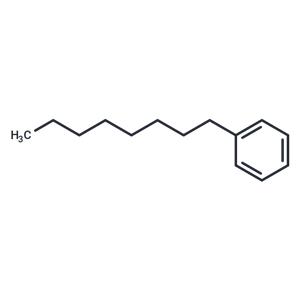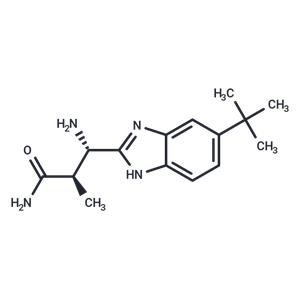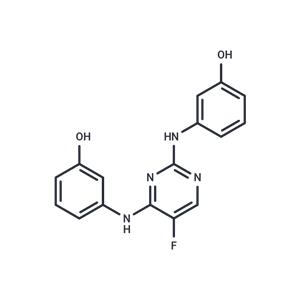Product Details
| Product Name:
ML327 |
CAS No.:
1883510-31-3 |
| Purity:
99.48% |
Supply Ability:
10g |
| Release date:
2024/11/19 |
Product Introduction
Bioactivity
| Name | ML327 |
| Description | ML327 is a MYC blocker. ML327 can also de-repress E-cadherin transcription and reverse Epithelial-to-Mesenchymal Transition (EMT). |
| Cell Research | ML327 is solubilized in DMSO for in vitro experiments.Cells are seeded onto 96-well plates at equivalent density (3,000 to 10,000 depending upon cell line), permitted to attach overnight, and treated with either ML327 (10 μM) or vehicle. Daily absorbance measurements (450 nm) using the cell counting kit are obtained. For estimation of IC50 values, cells are plated at equal density, permitted to attach, and baseline absorbance is obtained using cell counting kit. Cells are then treated with varying doses of ML327 (0.1 to 30 μM) and cell viability is measured 72 h after treatment. |
| Animal Research | ML327 is solubilized in 70% polyethylene glycol for in vivo experiments.Male athymic nude mice (4 to 6 weeks old) are maintained as described. BE(2)-C cells xenografts are established as previously described. 1×106 cells/100 μL of HBSS is injected subcutaneously into flanks using a 26-gauge needle (n=10 per group). Mice are monitored daily for xenograft formation and assessed by measuring the two greatest perpendicular tumor diameter with venier calipers. Xenograft volumes are estimated using the following formula [(length×width2)/2]. Once tumors reach 75 to 100 mm3, mice are randomized to receive either 50 mg/kg of ML327 or control vehicle (70% polyethylene glycol) via intraperitoneal injection twice daily for 14d. Weight and tumor volume are recorded daily. After completion of two weeks of treatment, mice are euthanized and tumors are excised, weighed, and RNA is isolated. |
| In vitro | ML327 partially restores E-cadherin expression at the plasma membrane in NMuMG cells induced to undergo Epithelial-to-Mesenchymal Transition (EMT) by TGF-β1 treatment. Treatment with ML327 induces an elongated morphology in neuroblastoma cells. BE(2)-C cells treated with ML327 demonstrates G1 cell cycle arrest with a concordant decrease in S phase population, and a significant increase in the sub G0 population. ML327 induces the expression of CDH1 in all seven of the neuroblastoma cell lines with a 50 to 1,400-fold induction of CDH1 mRNA expression. ML327 blocks the expression of MYC family of oncogenic transcription factors in all tested neuroblastoma cell lines. Immunoblotting time course demonstrates early repression of N-MYC expression within 2 h of treatment with ML327 (10 μM). p53 levels are also suppressed by treatment with ML327. |
| In vivo | Treatment with ML327 leads to a significant reduction in MYCN expression, evidenced by a two-fold decrease, thus verifying its inhibitory effect on xenograft MYCN expression (p=0.0035). Furthermore, ML327 markedly diminishes tumor volume, achieving a three-fold reduction over a two-week period (p=0.02), and similarly, tumor explant weights in ML327-treated mice are approximately three-fold lighter compared to those in control mice (p=0.01). Additionally, ML327 administration results in a 12% greater loss of body weight in treated mice compared to those receiving the vehicle. |
| Storage | Powder: -20°C for 3 years | In solvent: -80°C for 1 year | Shipping with blue ice. |
| Solubility Information | DMSO : 13.75 mg/mL (37.53 mM)
|
| Keywords | Autophagy | Myc | Inhibitor | ML-327 | inhibit | ML327 | ML 327 | c-Myc |
| Inhibitors Related | Stavudine | Xylitol | Myricetin | Sodium 4-phenylbutyrate | Hydroxychloroquine | Guanidine hydrochloride | Taurine | Curcumin | Oxyresveratrol | Paeonol | Naringin | Gefitinib |
| Related Compound Libraries | Glycolysis Compound Library | Reprogramming Compound Library | Bioactive Compound Library | Autophagy Compound Library | Inhibitor Library | NO PAINS Compound Library | Bioactive Compounds Library Max | Cell Cycle Compound Library | Wnt/Hedgehog/Notch Compound Library | Anti-Cancer Compound Library |
Company Profile Introduction
Target Molecule Corp. (TargetMol) is a global high-tech enterprise, headquartered in Boston, MA, specializing in chemical and biological research product and service to meet the research needs of global customers.
TargetMol has evolved into one of the biggest global compound library and small molecule suppliers and a customer based on 40+ countries. TargetMol offers over 80 types of compound libraries and a wide range of high-quality research chemicals including inhibitors, activator, natural compounds, peptides, inhibitory antibodies, and novel life-science kits, for laboratory and scientific use. Besides, virtual screening service is also available for customers who would like to conduct the computer-aided drug discovery.
You may like
-
CAS:2189-60-8
$30.00 / 5mg
-
CAS:1449473-97-5
$44.00 / 1mg
-
CAS:575474-82-7
$33.00 / 1mg
Recommended supplier
| Product name |
Price |
|
Suppliers |
Update time |
|
|
$/ |
|
Anhui Ruihan Technology Co., Ltd
|
2023-08-21 |








 United States
United States